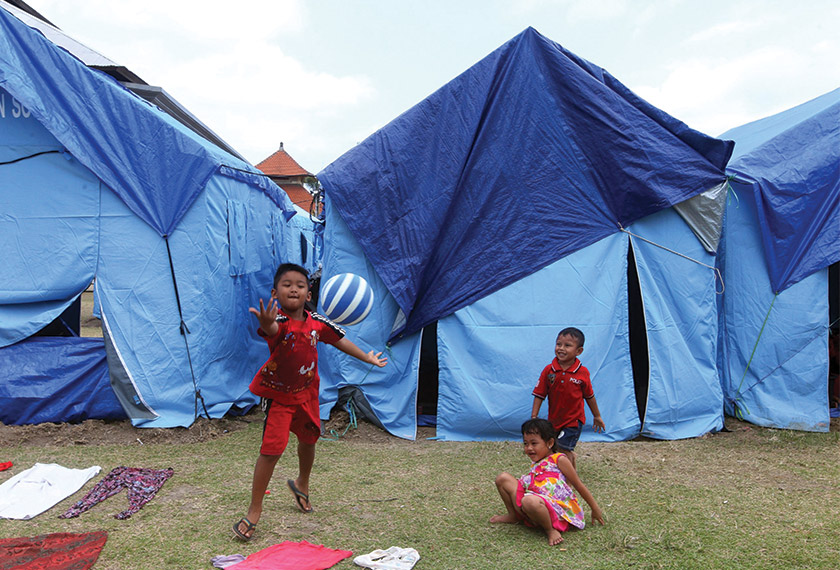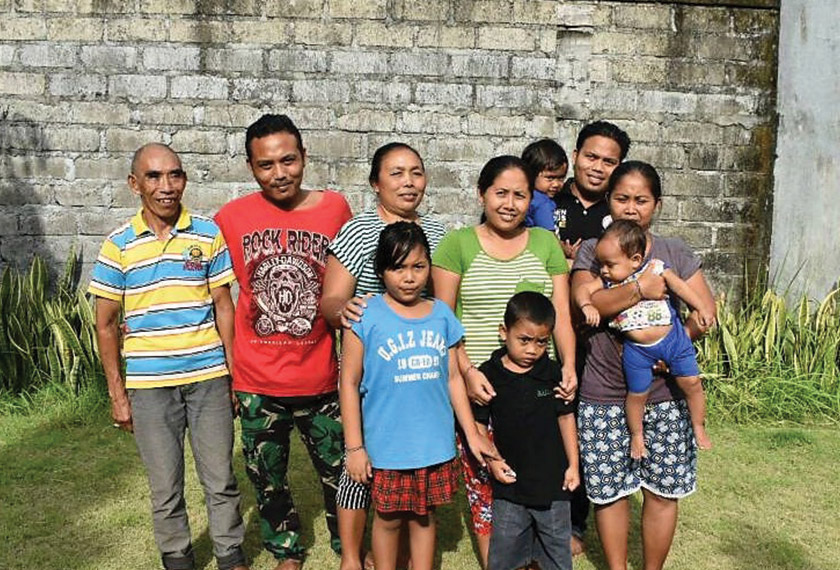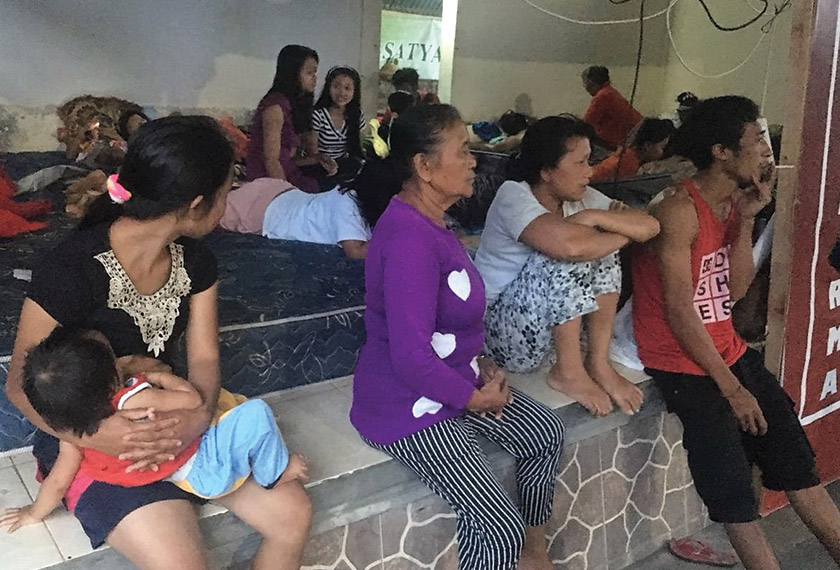Pyroclastic flows—a fast-moving mixture of gas and volcanic matter—devastated the villages around the sacred mountain. The only place spared was the Mother Temple of Besakih which the lava missed by metres.
Since 21 September, fears of a similar catastrophe have gripped the island, causing panicked villagers to flee. At the time of writing, nearly 150,000 evacuees are scattered across 471 relief centres.
On 1 October, the Ceritalah team travelled to the outskirts of Gianyar (approximately 62 km from Mount Agung) to visit a privately-funded relief centre close to the town's football stadium.
There, sitting on the steps of a community hall-turned-refuge, we met Nyoman Gerti, a 52-year old grandmother of five from the village of Ababi on the slopes of Mount Agung.
Plump and lively, she told us: "On 21 September, we felt the first quake in the middle of the night. I woke up and grabbed the grandchildren. There was chaos. Everyone ran out of their homes.”
“The people who remembered the 1963 eruption told us to keep away from rivers, to stay closer to higher ground to be safe. I refused to sleep in the house again!"
“But the tremors kept on coming back—two or three times a day. I couldn’t sleep, concentrate or eat. So, two days later, we all moved here. I still worry about the house, but I can rest easier knowing we are far away from the volcano.”
Strangely, there are very few working-age men at the centre. Ibu Nyoman explained: "Our families are divided. My husband and sons are still in the village. They are guarding our belongings and taking care of the livestock. The women and the older folk are here with the children, where it’s safe.”
Curious, I asked aloud if this was the case for most families. All the women present put up their hands.

Ibu Nyoman cited her two cows (plus one calf), ten pigs and chickens. Each cow normally would be worth IDR8/10,000,000 and the pigs over IDR1,000,000 each. Shaking her head, she adds: "They are too valuable to be left alone. They are our livelihood. If we lose them, we have nothing.”
"It’s too dangerous for us to go back. Every day, there are three to four quakes. The younger men can get away quickly on their motorbike if anything happens.”
I ask her if she misses her men and she replies stoically: “I’m used to it…Usually, my sons who work as masons go off to the cities and they only come back once every 10 days.”
Today’s situation is an ironic reversal of that, with the women in the cities and the men staying home.
But life before the latest emergency wasn’t idyllic for Ibu Nyoman.

“Our village only got electricity 7 years ago. Before that, we were still using oil lamps. There are no asphalt roads, only concrete tracks.”
Ibu Nyoman runs a small sundry stall in her village. On average, she earns IDR15,000 (about USD1) a day.
“Sometimes, I have enough to feed everybody. Other times, I go hungry so my grandchildren can eat. The economic situation has actually worsened since my father’s time: there are no jobs in the village.”
Despite her daily hardships, Ibu Nyoman beams when she talks about Putu Dobriani, her 17-year-old granddaughter.
“Her mother—my daughter—passed away from throat cancer when the girl was only 3 years old. I’ve raised her as my own ever since.”
“I never learned to read or write. My father was a priest, so he was always at the temple and didn’t have money to send me to school. With Dobriani, I was determined to give her an education.”

“She’s now in high school. The first one in the family to do so. She rides her motorbike to school every day and when she graduates, she really wants to work in a hotel. Her dream is to one day get a laptop…”
But the eruption of Mount Agung could take away what little progress has been made.
Indeed, later that day when we returned to meet her two strapping sons, they whispered to us – as if not to upset their mother – that they'd been forced to sell the livestock at a deep discount.
Ibu Nyoman remains troubled by the disturbances: "I don’t know why this is happening. Maybe God is angry because we have done something wrong? Maybe it’s the mining? They must be disturbing Nature. Maybe it’s because people have been climbing the mountain and disrespecting it?"
“I don’t even know when or if it will erupt. There’s a ritual for the fourth full moon on 3 October. I wanted to go back but my son told me it’s too dangerous. It’s the most important full moon of the year…I feel deeply disappointed.”
For the Balinese, life revolves around worship. Their beliefs and rituals are embedded into their sense of balance in the world. Cancelling or postponing a major ritual is a grave matter, considered an affront to God.
“I want to pray for safety. For my family’s future. I hope that maybe if I pray enough, God will have mercy on us.”
Still, I can’t help but feel that there are more worldly solutions to the island’s problems.
Bali will recover, as it has from countless natural and man-made disasters: its people’s resilience will see to that.
But its leaders should also think of the future.
READ MORE ARTICLES ON CERITALAH ASEAN HERE
Tourism in Bali has enjoyed 20% year-on-year growth. Last year, 4.4 million foreign tourists came to the predominantly Hindu island. The result has been rapid development, with dozens of hotels popping up every year.
But the economic benefits are uneven. While the south of the island is bursting at the seams with visitors, villages in the remote north – like Ababi, have been neglected.
This imbalance must be addressed. A key initiative – after everything has settled down – would be to revive long-stalled plans for an airport in the north, closer to the port city of Singaraja.
This would ease congestion at the Ngurah Rai airport in the south and spread the benefits of tourism to the overlooked but remarkably beautiful, unspoilt north of the island.
The latest volcanic activity should be an impetus for action, not more inertia.
NOTE: Follow Karim Raslan on Twitter @fromKMR / Instagram @fromkmr



























